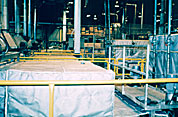| |
Basic Construction: Insulation Layers

|
|
Various insulation layers are available. These include the following:
Man-Made Mineral Fiber
The usual candidates are available for this application. They include both rock wool and fibrous glass wool held together with an organic binder. Selection of this insulation material depends on the application. The main considerations, in addition to thermal conductivity, are the flexibility of this layer for handling during many installations and removals over the life of the finished insulation. Also, resistance to compression has to be considered. Compression could reduce the effective thickness of the insulating layer.
Needled Man-Made Mineral Fiber and Ceramic Mats
These don't use the usual organic binders to hold the mat together. They're nonwoven and held together by mechanically "needling" the internal fibers of the mat together using a special process. The usual organic binders start to decompose (oxidize) at around 400 degrees F. Use of organic binders above this temperature would cause loss of binder and cause degradation of the insulation to an extent that it would compress and lose thickness due to diminishing compressive strength. Also, loss of binder could lead to disintegration of the insulation layer. Needled man-made mineral fibers would therefore generally be used on installations operating in temperatures ranging from above 400 degrees F up to about 1,000 degrees F. Needled ceramic mat would be used in the highest temperature applications.
Other Specialized Materials
These may be specified and used depending on the application.
|
|

